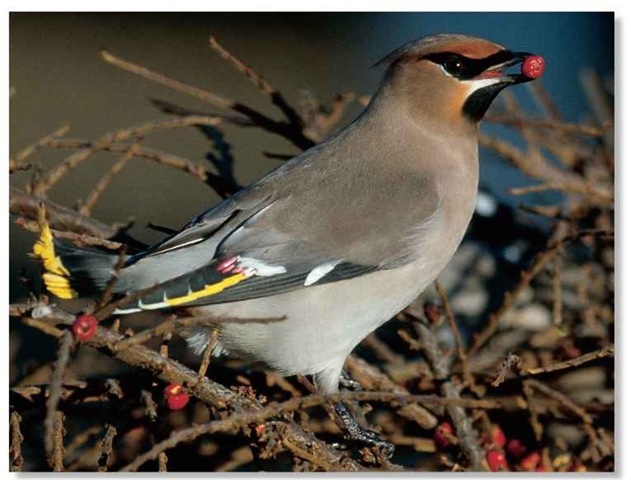ORDER
Passeriformes
FAMILY
Bombycillidae
GENUS & SPECIES
KEY FEATURES
• Has waxlike ornaments on its wings, and thick \ feathers to insulate it from sub-Arctic temperatures J • Sporadically leaves home to roam when its food supply cannot support the population • indulges in a courtship display, where a gift is passed back and forth between a mating pair
WHERE IN THE WORLD?
Breeds in sub-Arctic regions of northern Europe, Siberia, Alaska and western Canada; usually migrates south of its breeding range in autumn
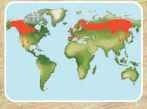
Lifecycle
The Bohemian waxwing usually spends winter in northern forests, but when facing starvation it wanders long distances, never knowing where it will find its next meal.
HABITAT
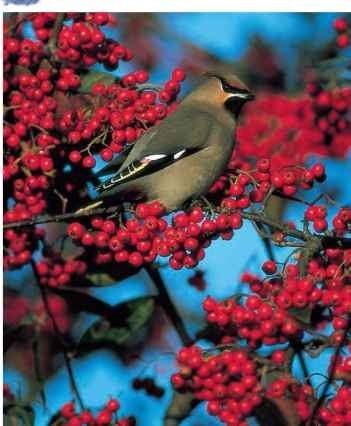
A Seeing red
The waxwing is attracted by trees with ripe berries.
The Bohemian waxwing breeds in largely coniferous taiga forests that span the sub-Arctic, south of the treeless tundra. These
dense woods are dominated by pine and spruce, which tower over deciduous birch and aspen. The largest populations live in the lowlands, with others on the slopes of upland valleys.
In autumn, the bird leaves the conifer forests and moves south of its breeding area where rowan, or mountain ash, is numerous. However, when circumstances force the waxwing to make long migrations, its habitat changes far more dramatically. A bird accustomed to wild surroundings adapts readily to life among city parks, town gardens or wherever there are berry-bearing trees.
BEHAVIOR
The Bohemian waxwing, like other birds that breed in the Arctic, has a boom-or-bust lifecycle. Every 10 years or so, when its population exceeds the limited winter food supply, the risk of starvation forces the waxwing to flee its home in a large-scale migration, known as an irruption.
An irruption occurred in January 1996, when 10,000 waxwings invaded Britain. In the U.S., New England felt this same influx with hundreds showing up in areas where they had not been seen before.
Many waxwings die of starvation or exhaustion in irruption years. When survivors return to their breeding grounds, the natural habitat is rejuvenated and can support the reduced numbers.The population increases until the next winter food crisis. The waxwing has a peaceable nature and spends most of its life in flocks. Its voice is feeble, consisting of a quiet trill, given in flight.
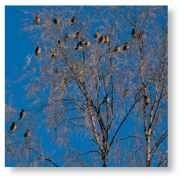
A Waxworks These sociable birds feed and breed in large flocks.
FOOD & FEEDING
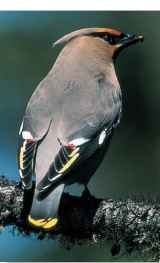
A Opportunity knocks The waxwing waits to snap up any passing insects.
From autumn to spring, the Bohemian waxwing eats the berries of conifer trees and shrubs, especially mountain ash.
It eats buds, flowers, young shoots, leaves and even tree sap in early spring, after the berry season has finished and before the emergence of insects.
In the brief summer, which is also its breeding season, the waxwing exists mostly on mosquitoes and midges. It dashes out from treetops to snap them up in midair before returning to the same perch. Sometimes it feeds by zigzagging through an insect swarm.
DRIVEN TO MIGRATION

1 Plunder…
The Bohemian waxwing favors mountain ash berries, so the supply is soon exhausted. If food is scarce, waxwings scatter in search of food.

2 Irrupt…
Flocks abandon their regular wintering areas and search for any trees that still bear berries; gardens are often their only hope.
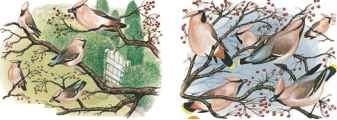
3 Settle…
Many waxwings descend on a single tree and strip it before moving on. They feed acrobatically, often hanging upside down on branches.
4 Feast
The waxwing eats up to three times its weight of fruit in a day. Individuals have been known to swallow 300 berries in two hours.
The Bohemian waxwing drinks copiously to help digest large quantities of berries. It eats snow and catches snowflakes.
# Before the waxwing’s mysterious appearances in places where it was unknown nor understood, it earned a reputation as a bird of ill omen. In the Netherlands, where it is still known as “pest bird,” people believed the waxwing brought with it war, pestilence and famine.
CONSERVATION
Bohemian waxwing numbers fluctuate naturally with the winter berry crop. Logging in the bird’s breeding areas may cause short-term local declines, but there are no threats to its future on a wider scale.The trend toward labor-saving gardening — which has brought an increase in the planting of berry-bearing shrubs and ornamental trees — is helping more waxwings survive severe winters.
BREEDING
When the breeding season starts in May the male looks for a mate. He courts a female by passing her a “gift” in his bill. It may be a berry insect, ant pupa or even an inedible piece of bark A receptive female receives the gift and holds it in her bill for a few seconds before returning it to her suitorThe male also raises his crest and puffs up his rump and belly feathers to make himself look larger and almost spherical. In addition, he chases the female in flight.
Stunted pines with hanging lichen are favorite nest sites.The nest is an open cup made from a base of twigs, lined with grass, reindeer
moss and lichens. The male feeds his mate insects as she incubates the bluish, speckled eggs.The young are fed by both adults on regurgitated insects and fledge after two weeks.
Family retreat Bohemian waxwings nest high above the ground.
Proud parent The mother finds food for the young.
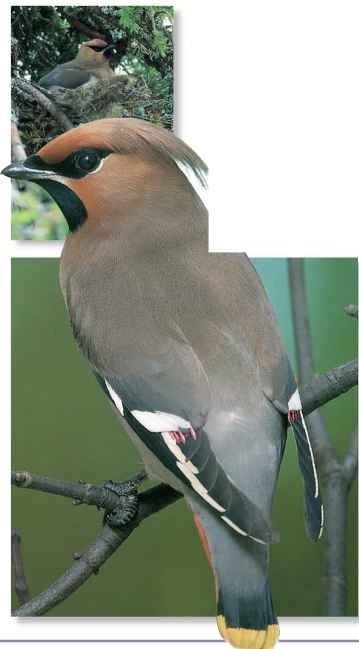
Profile
Bohemian Waxwing
The elegantly crested Bohemian waxwing is easily identified by the loud, rattling noise made by its wing appendages during takeoff and landing.
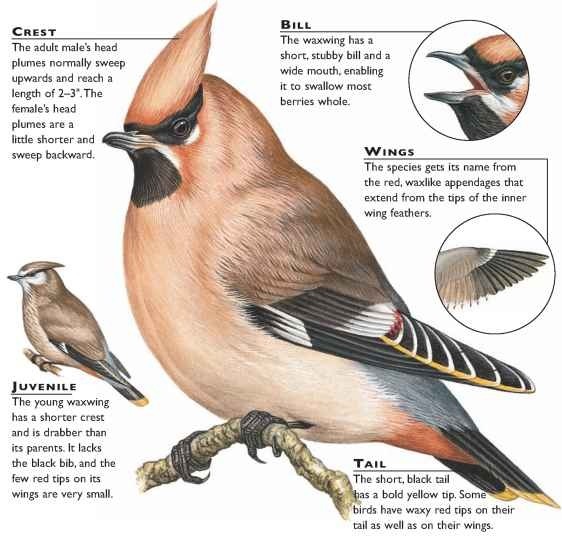
CREATURE COMPARISONS
The waxwing family includes four ‘ species of silky flycatcher; one is known only by its scientific generic k name, the phainopepla, (Phainopepla nitens). It occurs from Mexico into
southwestern U.S.
The male is black with white flashes on his primary wing
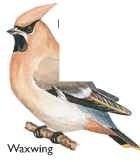
feathers; the female is olive-gray The species is much slighter than the Bohemian waxwing but the same length; its tail accounts for half of its overall 8″. It shares the waxwing’s swept-back crest and soft plumage. It’s fond of mistletoe berries, and catches flying insects in spectacular swoops. Phainopepla
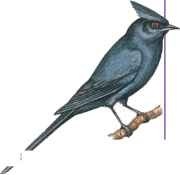
| STATISTICS Weight 1.75-2.8 oz. |
|
| Length | 8″ |
| Wingspan | 13-14″ |
| Sexual Maturity | 1-2 years |
| Breeding Season | Late May -June |
| Number i of Eggs | 4-7 |
| Incubation Period | 12-15 days |
| Fledging \ Period | 14-16 days |
| Breeding Interval | 1 year |
| Typical Diet | Birch, spruce,/ : alder seeds; fruits, buds; mosquitoes and midges |
| Lifespan | Up to 12 years |
RELATED SPECIES
• Two species, both of which are very similar to the Bohemian waxwing, share its name.The cedar waxwing, Bombycilla cedrorum, breeds in the U.S. and eastern Canada; the Japanese waxwing, B. japonica, occurs in Japan and northern Manchuria. The cedar waxwing is smaller, with no yellow on its wings; the Japanese species has a red-tipped tail but lacks waxy tips.
